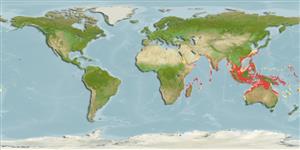Environment: milieu / climate zone / depth range / distribution range
Ecologia
marinhas; estuarina demersal; anfídromo (Ref. 51243); intervalo de profundidade 10 - 100 m (Ref. 12260). Tropical; 30°N - 30°S
Indo-West Pacific: from India to Papua New Guinea; north to Japan; south to Australia,
Comprimento de primeira maturação / Tamanho / Peso / Idade
Maturity: Lm 9.4 range ? - ? cm
Max length : 23.0 cm TL macho/indeterminado; (Ref. 12260); common length : 15.0 cm TL macho/indeterminado; (Ref. 5450); idade máx. registrada: 2.30 anos (Ref. 4544)
Espinhos dorsais (total) : 8; Raios dorsais (total) : 16; Espinhos anais: 3; Raios anais : 14; Vértebras: 24. This species of the Leiognathus splendens complex is distinguished by the following characters: no scales on cheek; anterior dorsolateral body surface almost completely scaled without a semicircular naked area on nape; lower margin of inner preopercular ridge is smooth or weakly serrated (including the neotype); interspace of pelvic keels without scales; second spines of dorsal and anal fins are robust (width of second spines of dorsal and anal fins 0.87-1.6% of SL and 0.76-1.7% of SL, respectively); a jet black blotch on spinous dorsal fin (Ref. 75583).
This schooling species inhabits coastal waters. It feeds on fish, crustaceans, foraminiferans, and bivalves (Ref. 5213). The annotated bibliography of Leiognathidae by Pauly and Wade-Pauly (Ref. 4961) includes 172 references pertaining explicitly to Leiognathus splendens.
Lipid stored in muscles, liver and intestine decreased during gonadal maturation and following spawning (Ref. 3655).
Kimura, S., T. Ito, T. Peristiwady, Y. Iwatsuki, T. Yoshino and P.N. Dunlap, 2005. The Leiognathus splendens complex (Perciformes: Leignothidae) with the description of a new species, Leiognathus kupanensis kimura and Peristiwady. Ichthyol. Res. 52 (3):275-291. (Ref. 75583)
Status na Lista Vermelha da UICN (Ref. 130435)
Uso pelos humanos
Pescarias: espécies comerciais
Ferramentas
Relatórios especiais
Baixar XML
Fontes da internet
Estimates based on models
Preferred temperature (Ref.
123201): 24.8 - 29.1, mean 28.1 °C (based on 1680 cells).
Índice de diversidade filogenética (Ref.
82804): PD
50 = 0.5625 [Uniqueness, from 0.5 = low to 2.0 = high].
Bayesian length-weight: a=0.01950 (0.01525 - 0.02494), b=2.97 (2.90 - 3.04), in cm total length, based on LWR estimates for this species (Ref.
93245).
Nível Trófico (Ref.
69278): 2.9 ±0.38 se; based on food items.
Generation time: 1.2 (1.0 - 1.4) years. Estimated as median ln(3)/K based on 22
growth studies.
Resiliência (Ref.
120179): Elevada, tempo mínimo de duplicação da população menor que 15 meses (K=0.33-1.60; tm=1; tmax=2.3).
Fishing Vulnerability (Ref.
59153): Low vulnerability (15 of 100).
Nutrients (Ref.
124155): Calcium = 301 [127, 1,001] mg/100g; Iron = 1.94 [0.82, 4.73] mg/100g; Protein = 18.3 [16.3, 20.6] %; Omega3 = 0.231 [0.128, 0.423] g/100g; Selenium = 125 [48, 357] μg/100g; VitaminA = 4.78 [0.90, 27.87] μg/100g; Zinc = 2.33 [1.09, 4.14] mg/100g (wet weight); based on
nutrient studies.
